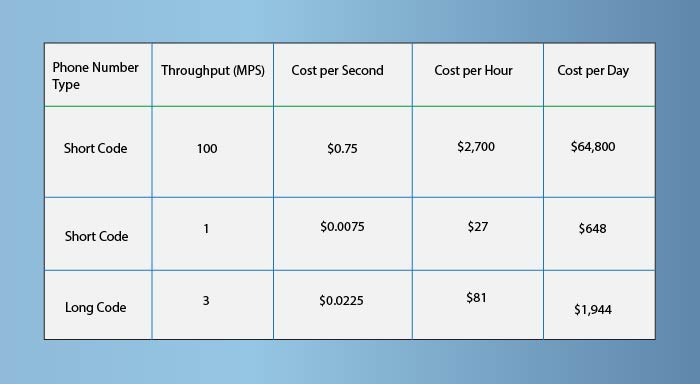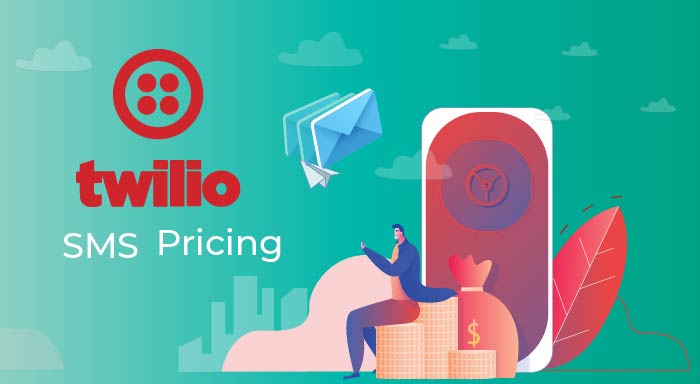Twilio's pay-as-you-go pricing functionality is one of the most compelling features of this platform. The "only pay for what you use" slogan has made Twilio widely popular among businesses of all sizes.
However, many users are still perplexed about the pricing model for Twilio's communication services, including SMS, calls, MMS, email, WhatsApp messages, and more. Common questions include how many SMS messages can be sent per second, hourly and daily costs, and the importance of A2P 10DLC.
In this blog post, we will explore the updated SMS pricing model of Twilio and explain its structure.
Twilio SMS Pricing: The Basics
Twilio's SMS pricing is not uniform; it varies based on the country and type of phone number used. For instance, the cost of sending an SMS in the United States differs from the cost in other countries. Moreover, the price of Twilio SMS varies depending on whether you use a long-code number, short-code, or toll-free number.
Let's delve into the specifics of Twilio’s SMS pricing in the United States, focusing on long code, short code, and Toll-free Numbers.
Cost Breakdown: An Overview of the Pricing
Let's calculate the cost based on the maximum throughput for each type of number:
Short Code Numbers:
- Throughput: Up to 100 messages per second (MPS)
- Price: $0.0075 per SMS segment
Long Code Numbers:
- Throughput: Up to 1 message per second (MPS)
- Price: $0.0075 per SMS segment
Toll-Free Numbers:
- Throughput: Up to 3 messages per second (MPS)
- Price: $0.0075 per SMS segment
Let’s Understand “Throughput”: What is it?
Throughput refers to the rate at which you can send messages over a given period which is measured by per phone number and per second. Different phone numbers have their varying throughput rates, such as, Twilio short code numbers can send up to 100 Messages per Second (MPS).
For Example:
Consider a customer with a pool of four short code numbers. Each number can send 100 messages per second, consequently, a total throughput of 400 MPS. However, if there is traffic congestion then this maximum throughput will not reach its limit just like the way “a busy highway slows down traffic speed”.
Account-Based Throughput: What is the Role of it?
Account-based throughput means the Twilio Platform now sets a limit on how many messages you can send for your whole account not only for a phone number. This makes it easier to manage and predict your messaging procedure:
- Simplified Management: You need fewer phone numbers to send the same number of messages.
- Improved Predictability: Your messaging rate stays steady, no matter how many numbers you have.
- Better Control: You can plan better and avoid delays during busy times.
Real-Life Scenario: Suppose you are taking a train as a commuter within a consistent schedule. While not as fast as a clear highway drive. But the train's speed would be consistent and more predictable even when the drive of the highway will run on its peak latency. Which makes travel more reliable.
Message Queues and Limits
When the request of messages exceeds the account-based MPS then messages are in queued or waiting for sending or receiving. Each channel and sender combination has a separate queue whereas messages need to remain in the queue for up to 4 hours.
Queue Example:
Consider Owl Inc., which uses both short codes and toll-free numbers to send SMS and MMS traffic. This setup results in four queues:
- SMS Short Codes: 500 MPS, the maximum queue length would be 7,200,000 segments.
- SMS Toll-free: 100 MPS, the maximum queue length would be 1,440,000 segments.
- MMS Short Codes: 100 MPS, the maximum queue length would be 1,440,000 segments.
- MMS Toll-free: 25 MPS, the maximum queue length would be 360,000 segments.
A Break-down of costs Based on Number’s Code: Per Second, Per Hour, Per Day
Calculating the entire cost based on seconds, minutes, hours, and days can be a perplexing task that will take your precious time. So, here, we have given a concise list of the pricing model of SMS based on the different codes of the numbers. Therefore, have a look-
Short Code Numbers
Per Second:
100 messages * $0.0075
Total cost $0.75
Per Hour:
100 messages/second * 3600 seconds = 360,000 messages/hour
Cost per hour: 360,000 * $0.0075 = $2,700
Per Day:
360,000 messages/hour * 24 hours = 8,640,000 messages/day
Cost per day: 8,640,000 * $0.0075 = $64,800
Long Code Numbers
Per Second:
1 message * $0.0075
Total Cost - $0.0075
Per Hour:
1 message/second * 3600 seconds = 3,600 messages/hour
Cost per hour: 3,600 * $0.0075 = $27
Per Day:
3,600 messages/hour * 24 hours = 86,400 messages/day
Cost per day: 86,400 * $0.0075 = $648
Toll-Free Numbers
Per Second:
3 messages * $0.0075
Total Cost = $0.0225
Per Hour:
3 messages/second * 3600 seconds = 10,800 messages/hour
Cost per hour: 10,800 * $0.0075 = $81
Per Day:
10,800 messages/hour * 24 hours = 259,200 messages/day
Cost per day: 259,200 * $0.0075 = $1,944
Let’s Recap Within a Single Look

Final Thought
Twilio's SMS pricing model is dynamic and varies by country and type of phone number used. An understanding of the throughput rates, message queuing, and the benefits of account-based throughput can help businesses optimize their messaging strategies. In addition to this, compliance with A2P 10DLC is crucial for maintaining high-quality messaging and avoiding regulatory issues. By leveraging Twilio’s flexible and scalable pricing and throughput models, businesses can ensure efficient and effective communication with their customers.



